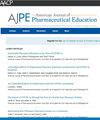Connecting Power Types and Leadership Approaches in Academia Can Enhance Our Influence and Maximize Impact
IF 3.8
4区 教育学
Q1 EDUCATION, SCIENTIFIC DISCIPLINES
引用次数: 0
Abstract
Power types are systems of influence that leaders can use when faced with an opportunity or challenge; thus, power types can be viewed as tools in a leader’s toolbox. Each tool has a unique purpose and can be used depending on the situation at hand. Just as individual strengths, leadership styles, and preferences among leaders, no one power type is better or worse than another. Although there is substantial discussion about leadership styles and personality preferences in the academic pharmacy literature, little is said about the use of power types in higher education administration, and even less in health professions education administration. Leaders across the Academy can benefit from understanding how to exert influence using various power-type approaches, whether they hold formal administrative positions or lead and influence without formal leadership titles. This commentary focuses on identifying approaches to power, distinct from leadership styles, and calls on both individual leaders and the Academy to integrate power types and power dynamics more coherently into conversations about leadership and leadership approaches. Like leadership styles and strengths, power types can be helpful when leaders are at their best and can work against them in times of stress. Understanding power types, along with their benefits and drawbacks, can help leaders at all levels better use their power, express their voice, and influence their locus of control.
连接学术界的权力类型和领导方法可以增强我们的影响力并最大限度地发挥影响。
权力类型是领导者在面对机遇或挑战时可以使用的影响力系统;因此,权力类型可以被视为领导者工具箱中的工具。每个工具都有一个独特的目的,可以根据手头的情况使用。就像领导者的个人优势、领导风格和偏好会有所不同一样,没有一种权力类型比另一种更好或更差。尽管在药学学术文献中有大量关于领导风格和人格偏好的讨论,但很少有关于高等教育管理中权力类型的使用,在卫生专业教育管理中甚至更少。整个学院的领导者都可以从了解如何通过各种权力类型的方法施加影响中受益,无论他们是否拥有正式的行政职位,还是在没有正式领导头衔的情况下施加影响和领导。这篇评论的重点是识别不同于领导风格的权力方法,并呼吁个人领导人和学院将权力类型和权力动力学更连贯地整合到关于领导和领导方法的对话中。就像领导风格和优势一样,权力类型在领导者处于最佳状态时很有帮助,在领导者处于压力状态时也会与他们作对。更多地了解权力类型及其优缺点,可以帮助各级领导人更好地使用他们的权力,表达他们的声音,并在他们的控制点施加影响。
本文章由计算机程序翻译,如有差异,请以英文原文为准。
求助全文
约1分钟内获得全文
求助全文
来源期刊
CiteScore
4.30
自引率
15.20%
发文量
114
期刊介绍:
The Journal accepts unsolicited manuscripts that have not been published and are not under consideration for publication elsewhere. The Journal only considers material related to pharmaceutical education for publication. Authors must prepare manuscripts to conform to the Journal style (Author Instructions). All manuscripts are subject to peer review and approval by the editor prior to acceptance for publication. Reviewers are assigned by the editor with the advice of the editorial board as needed. Manuscripts are submitted and processed online (Submit a Manuscript) using Editorial Manager, an online manuscript tracking system that facilitates communication between the editorial office, editor, associate editors, reviewers, and authors.
After a manuscript is accepted, it is scheduled for publication in an upcoming issue of the Journal. All manuscripts are formatted and copyedited, and returned to the author for review and approval of the changes. Approximately 2 weeks prior to publication, the author receives an electronic proof of the article for final review and approval. Authors are not assessed page charges for publication.

 求助内容:
求助内容: 应助结果提醒方式:
应助结果提醒方式:


